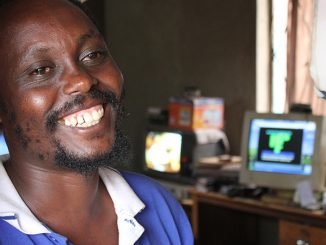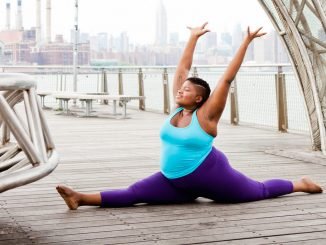
Kampala, Uganda | By Lindsey Kukunda | A Jamaican of Mali Origin, Pablo Imani is the principal yoga instructor in the Uganda Buddhist Center, a buddhist temple in Garuga. He gave me the ins and outs of how Afrikan yoga goes down.
K.D: So what’s the history of Afrikan Yoga?
Pablo: African yoga comes from ancient Egypt, not just as a political entity. As a country, it spans all the way down toward Uganda. Ancient Egyptians stated that their ancestors came from between the mountains of the moon and the source of theNile.This was documented by a Greek historian called Herodotus.The yoga is based on an ancient Egyptian principle. There are 24-36 postures and these could be found on the temple walls of ancient Egypt.
K.D: Documented by Herodotus, postures on walls in ancient Egypt. This Afrikan yoga is very zen.
Pablo: Back then, it was not called yoga. It was ‘smai tawi’. ‘Smai’ means union in Sanscript, while ‘Tawi’ means two lands. Philosophically speaking, it is the union of two lands- the upper and lower nature, the body and the spirit, and the balancing of masculine and feminine energy within the body.
K.D: What does masculine and feminine energy have to do with anything? Aren’t we purely masculine or purely feminine?
Pablo:Yes, but we must learn to understand opposing sexes. For instance, as a woman, you should tell a man what you think. Not what you feel. Men should tell women what it is that they feel. Men are about knowing, while women are about mystery.
K.D: By the way, you’re right.
Pablo: Exactly. I was taught to be a holistic health consultant. I learned about male and female principles. Balancing our opposing energies is the best way to get to the bottom of it.
K.D: So what do we gain from Afrikan yoga?
Pablo: Well, most people embrace yoga as a form of exercise, usually to relieve stress. In Europe, it’s practised for fitness as well as maintaining the stereotype of attractive bodies in the West.
K.D: You mean physical conformity?
Pablo: Very good. Exactly. Physical conformity. Is it okay if I steal that word?
K.D: Please do. So is yoga basically about being fit?
Pablo: That’s the mistake most people make. Yoga is not just about exercise or fitness in itself. It is a by-product of lifestyle.A good lifestyle is proper exercise, adequate nutrition, meditation, positive thinking, and how you treat other people. That is yoga philosophy all over the world.
K.D: The way you treat other people?
Pablo: If you’re good to yourself in all the ways I mentioned, you will generally be good to others. It’s about nourishing your spirit and soul, not only your body.
K.D: So what’s the difference between Afrikan yoga and the yoga Madonna is terribly good at?
Pablo: Think of it in terms of two video slides. On one side are people practising yoga in the Indian system and the other shows Afrikan yoga. The indian system is about maintaining body balance and sitting in static postures, while the Afrikan slide encompasses a very African flowing movement with the static postures.
K.D: Hhhm. Sounds unique. Could you be more specific about these flowing movements in static postures?
Pablo: Like I mentioned earlier, there are 24-36 positions. You start off with flowing motions called ‘hudu’ to begin with and focus on breath, and then move on to static postures. This takes 15-30 minutes.
The flowing motions, with your arms and your body, are to warm the body up adequately. Some people complain that they’ve come out of a yoga class and can’t walk for days. This is because their bodies haven’t been warmed up, and the mind has not been geared for the body to follow through with static postures. Hudu reprograms the body, making it ready for static movement.
K.D: Apart from Hudu, how best can someone prepare themselves for a yoga session?
Pablo: Yoga is best practised on an empty stomach, so you should eat 2-3 hours before your session. It’s best to wear loose clothing and to have some water before and after. Most of all, you should be focused. Switch off your mobile phone and leave your worries outside the door. When you’re done with yoga, they’ll still be there waiting for you. You’ll be better equipped to deal with them anyway.
Ideally, if you want to take it on as a lifestyle, you shouldn’t eat meat.
K.D: Oh no!
Pablo:I said ideally.
K.D: Oh, okay. Why is this? What does yoga have against meat?
In yoga philosophy, you’re not supposed to harm animals. Even if you didn’t kill the animal, you’re condoning it by eating it. Meat also carries a lot of toxins from the animal and yoga is about cleansing your body and mind for meditation. It’s about cleansing your life. Meat makes the body heavier, while vegetables and fruits keep it light.
Health-wise, meat causes arthritis and rheumatism because it carries acids and deposits salt in the joint bones. It takes 14 days or more to digest a steak. It’s sitting there justputrefyingin the colon. Most diseases start there, and you have to start going for colonics. Meat defeats the object of cleansing the body.
K.D: Erm, let’s move on. How else do you work with yoga in your day to day life?
Pablo: I’ve been teaching yoga for almost two years now. I also run the African yoga literacy project, which isabout bringingliteracy to children. We teach 7-14 year olds yoga, meditation andencouragethem to read. We’re also building a library.
I work with the Children’s Concern Project based in Kabalagala, as well as theBreak-danceProject. I also train individual students to become yoga trainers, and offer a one-to-one package which includes dietary advice, adequate exercise, a meditation program and an affirmation program.
K.D: An affirmation program?
Pablo:Yes. It’s a program that focuses on your needs. If you want prosperity and wealth, you get an affirmation for that as you train.
K.D: Awesome.
Pablo: Thanks. I’m now embarking on a partnership with different groups, to work with the Makerere University Psychology Department, to set up an African yoga meditation society.
K.D: With Makerere University? Good luck with that.
Pablo: Oh, you mean because of bureaucracy. Haha! Well, we shall hope and see.
K.D: So how about you take a colleague and i through a personal yoga session?
Pablo: Sure, let’s do this.
The Afrikan Yoga experience
Phone off, check.
Loose clothing, check.
Glass of water consumed, check.
Leaving worries out the door. Check.
African yoga can be very deceptive. Everything starts off very well indeed. And then it becomes excruciating. The Hudu flowing motions did warm our bodies up. We twirled our arms and hands for 20 minutes. By the time we stopped though, our arms were in aching agony.
We squatted and held positions. We stretched and held positions. We eased out the kinks in our necks and our backs and yes, even our groins.
We also received ‘affirmations’. While Imani usually does this depending on the needs of his students, this time we chanted general affirmations as we swayed our bodies to the music.
Read Also: How Yoga is getting popular in Uganda
“I am earth. I am water. I am fire. I embrace my feminine side. I embrace my masculine side”. Cool uplifting statements like that as we performed postures related to earth, water and fire.
At the end of it all, we faced each other in a circle, closed our eyes and meditated. The rigorous physical workout we had been subjected to left our minds open, with no energy to control our thoughts.
After those fifteen minutes of quiet meditation, when I went back to pick my worries, three quarters of them were gone. The session was an eye opener as to how unfit we as Ugandans are, and how necessary it is to adopt a new lifestyle to carry us through as better people into each New Year. You should all give it a try.
Pablo Imani holds individual and group sessions, and occasional out of town retreats. For more information, Imani can be contacted on pabloafrikanyoga@gmail.com



